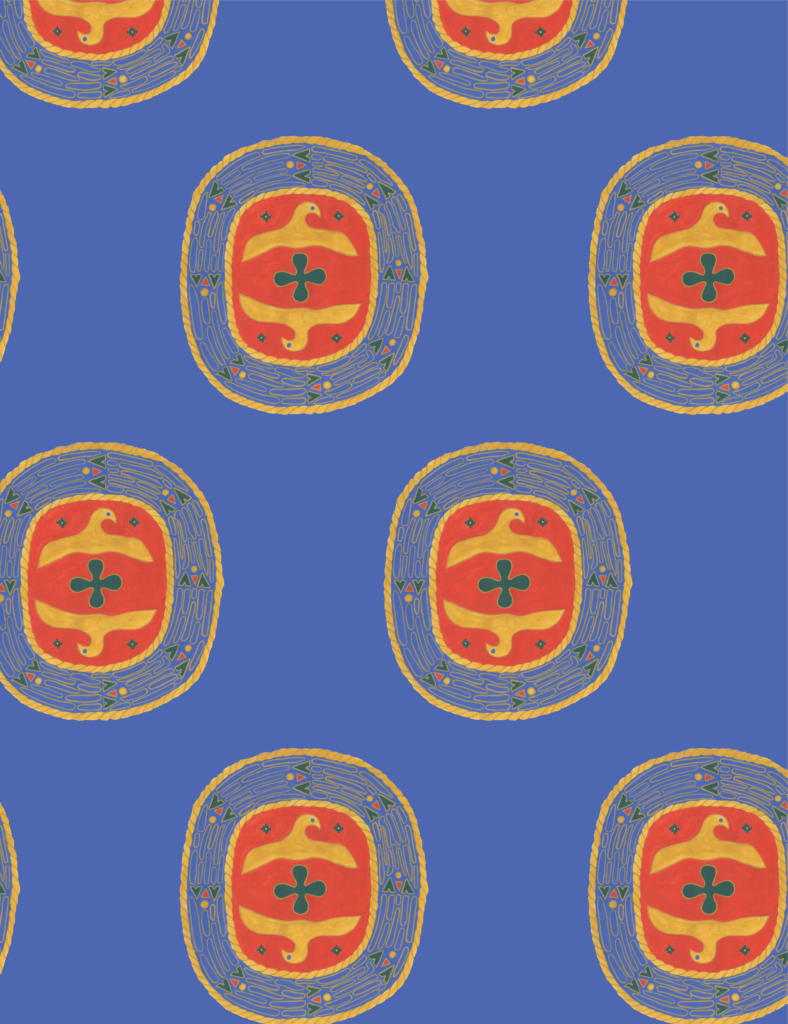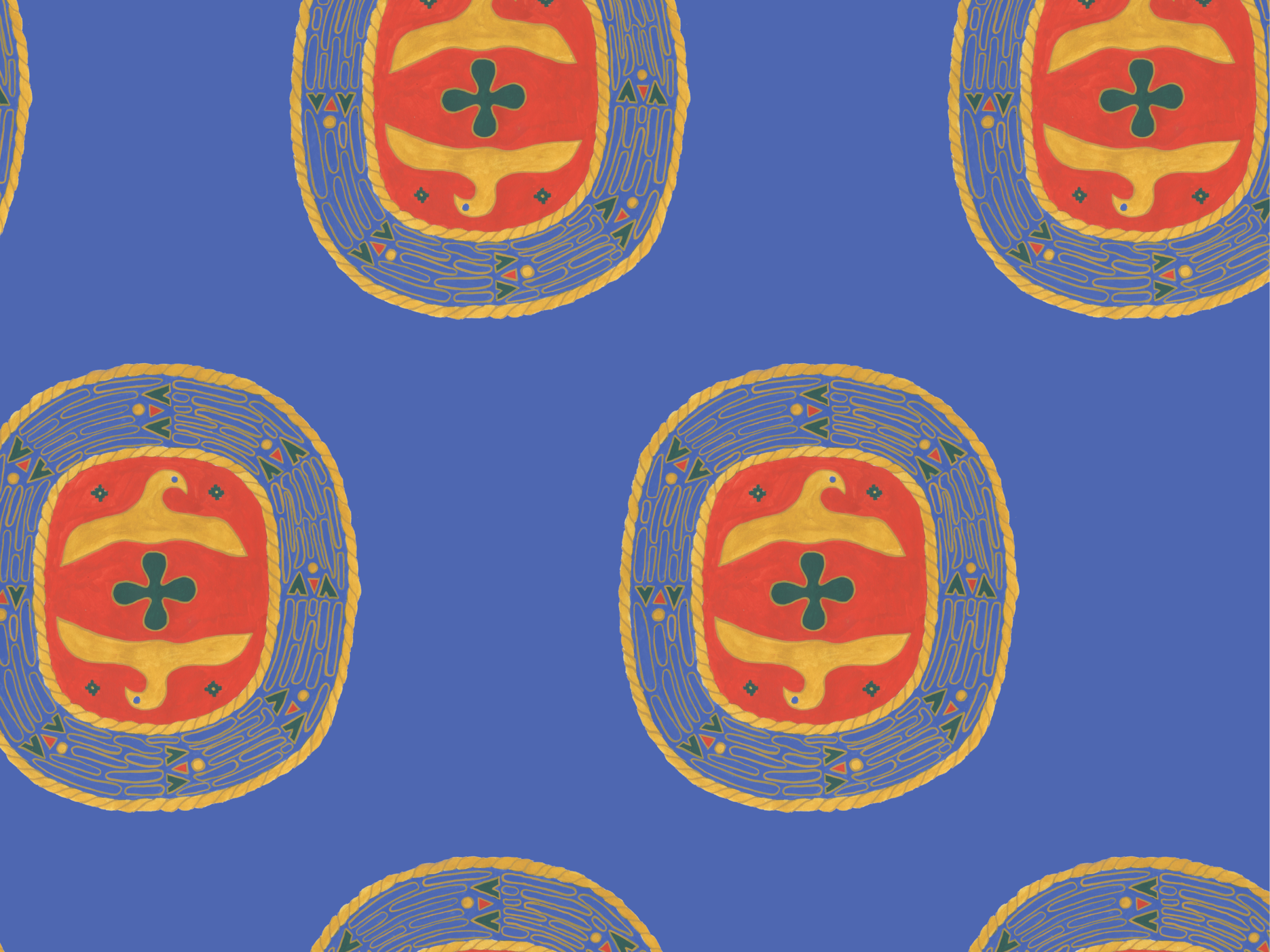



Inspiration Images:

Image 1: Altar Cloth or Podea

Image 2: Jaharis Byzantine Lectionary

Image 3: Medallion with Christ

Image 4: Medallion with Saint George

Image 5: Pendant Brooch with Cameo

Image 6: Textile

Image 7: Textile Fragment

Image 8: Tip of a Pointer
About the designs
As discussed in Survey of Historic Costume, Byzantine culture developed in Eastern Europe after Constantine established a new Roman capital in Byzantium, Greece (Tortora and Marcketti 108). The location of this city (renamed Constantinople) allowed access to the culture and art of the Middle East as well as that of Western Europe (Tortora and Marcketti 108-109). Byzantine architecture and costume were marked by “gold leaf, colored marble, bits of glass, and colored mosaics…made from small, colored stones and glass” (Tortora and Marcketti 110). Additionally, rich brocade fabrics “might be adorned with precious and semiprecious stones, small medallions of enamel, embroidery, and appliqués” (Tortora and Marcketti 111). These rich design elements of gold leaf, Middle Eastern-inspired motifs, and colorful stones are present in the inspiration images for my textile designs.
The first design, made of elongated roundel motifs in a hexagonal repeat pattern, was inspired by several of the research images. The layout of the design was inspired by the design on the Textile Fragment (image 7). The Textile Fragment also inspired the twisting rope rendered around the border of my motif, as did the rope engraved around the Pendant Brooch with Cameo (image 5). The gold detail on Christ’s garment in the Medallion with Christ (image 3) inspired the organic shapes filling the border of the motif, painted to look like inlaid stones or enamel. The jewel-toned shapes placed at intervals along the border were also inspired by the Medallion with Christ and the Medallion with Saint George (image 4), referencing the stones or enamel set in Christ’s book and Saint George’s garment. Within the center of my motif, on the red ground, the tiny rectilinear figures and the large central figure were inspired by the inlaid stones or enamel of the Tip of a Pointer (image 8). Byzantine textiles including animals depicted them as mirrored figures (ex. Altar Cloth or Podea (image 1) and Textile Fragment). The opposing figures of bird heads and wings in the center of my motif were inspired by this convention, although I mirrored the figures both vertically and horizontally to make the motif more balanced.
The second design, a striped repeat created by repeating rectangular and square motifs, references the borders around the Jaharis Byzantine Lectionary image (image 2) and the decorative clavi worn over the shoulders of men’s tunics (Tortora and Marcketti 112). The decorative borders above the doorframe and above the arches in the Jaharis Byzantine Lectionary painting inspired the zig-zag and zipper-like designs along the sides of my motif. The small squares with “Xs” inside of them were drawn from the squares woven into the grid of the silk Textile (image 6). The round, colorful stones set in gold around the Pendant Brooch with Cameo inspired the similar stone-like figures painted within the large gold squares of my motif. The periwinkle color of the carved cameo (also seen in the Jaharis Byzantine Lectionary image and in the halo around Christ’s head in the Medallion with Christ) inspired the color palette of this textile design.
My medium of choice was gouache, due to its vibrant, uniform color, which depicts flat, inlaid enamel and bright manuscript paintings well.
Works Cited
Byzantine Culture. Altar Cloth or Podea. 12.104.1. Late 14th century, silk, embroidery, The Metropolitan Museum of Art, New York. The Met, www.metmuseum.org/art/collection/search/473644. Accessed 23 Sept. 2018.
Byzantine Culture. Jaharis Byzantine Lectionary. 2007.286. Ca. 1100, tempera, gold, and ink on parchment; leather binding, The Metropolitan Museum of Art, New York. The Met, www.metmuseum.org/art/collection/search/477499. Accessed 23 Sept. 2018.
Byzantine Culture. Medallion with Christ from an Icon Frame. 17.190.678. Ca. 1100, Gold, silver, and enamel worked in cloisonné, The Metropolitan Museum of Art, New York. The Met, www.metmuseum.org/art/collection/search/464551. Accessed 23 Sept. 2018.
Byzantine Culture. Medallion with Saint George from an Icon Frame. 17.190.674. Ca. 1100, Gold, silver, and enamel worked in cloisonné, The Metropolitan Museum of Art, New York. The Met, www.metmuseum.org/art/collection/search/464547. Accessed 23 Sept. 2018.
Byzantine Culture. Pendant Brooch with Cameo of Enthroned Virgin and Child and Christ Pantokrator. 2007.9. Late 1000s-1100s (cameo); 1100s-1300s (mount), chalcedony cameo; gold mount with pearls, emeralds, garnets, sapphires, and a sardonyx intaglio, The Metropolitan Museum of Art, New York. The Met, www.metmuseum.org/art/collection/search/477247. Accessed 23 Sept. 2018.
Byzantine Culture. Textile. 46.156.48. 10th-11th century, silk, The Metropolitan Museum of Art, New York. The Met, www.metmuseum.org/art/collection/search/468141. Accessed 15 Sept. 2018.
Byzantine Culture. Textile fragment. 412-1890. Ca. 700-900, woven silk, Victoria and Albert Museum, London. V&A, collections.vam.ac.uk/item/O352808/textile-fragment-unknown/. Accessed 23 Sept. 2018.
Byzantine Culture. Tip of a Pointer. 1997.235. 1080-1150, Cloisonné enamel, gold, The Metropolitan Museum of Art, New York. The Met, www.metmuseum.org/art/collection/search/466296. Accessed 23 Sept. 2018.
Tortora, Phyllis G., and Sara B. Marcketti. Survey of Historic Costume. 6th ed., Bloomsbury Publishing Inc., 2015.
